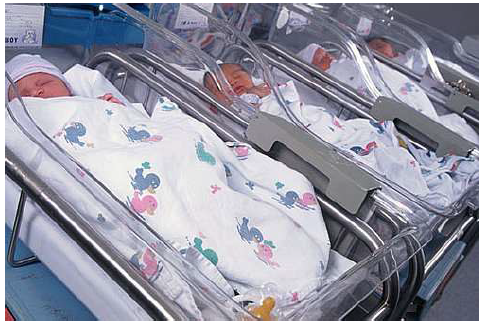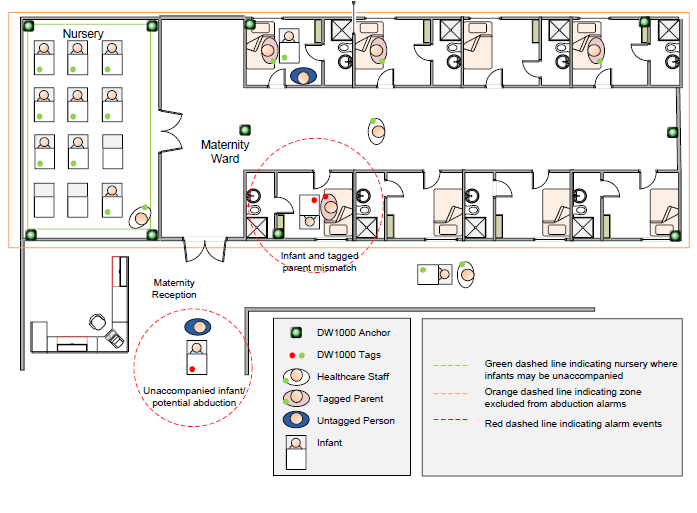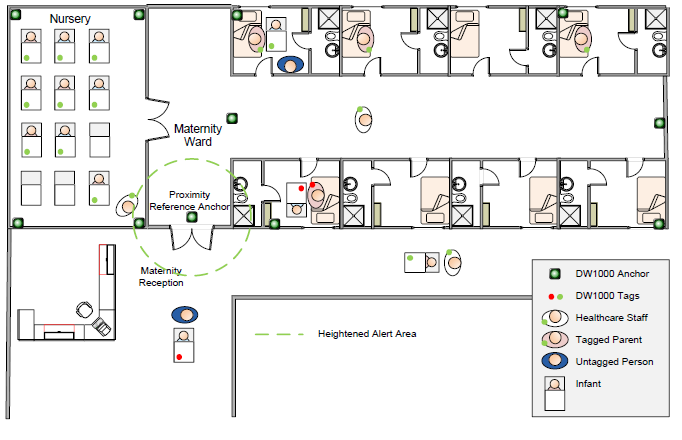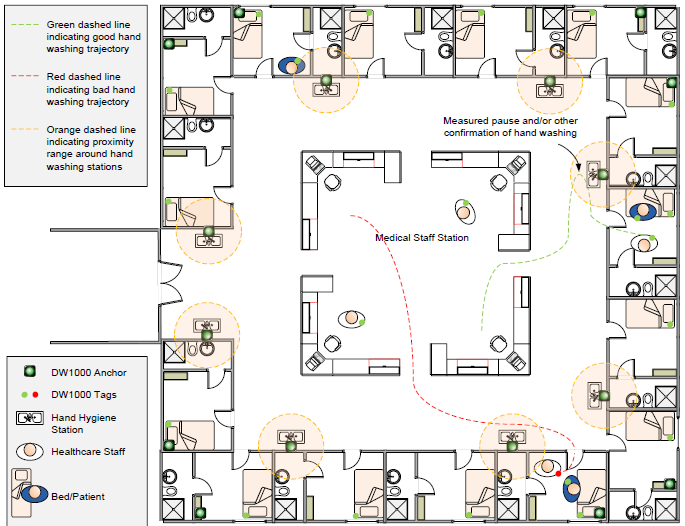- Home
- Symmetry Blog
- Potential Use of DW1000 in RTLS Targeting Health
The Potential Use of the DecaWave DW1000 in Real Time Location System (RTLS) Targeting the Health Care Market
Monday, August 25, 2014
The DecaWave DW1000 device may be integrated into many healthcare service provision and management systems, including:
- Supply chain and asset management
- Security and protection
- Patient and resident safety
The applications outlined below can be integrated in a facility-wide RTLS
1. Supply Chain and Asset Management
Problem - Medical equipment represents a large investment on the part of hospitals and healthcare facilities. Management of these resources can be difficult due to challenges locating items when needed. Portable assets such as resident lifts, wheelchairs, and thermometers are examples of equipment which hospitals frequently overbuy in order to deal with the problem of locating them when needed. Similar problems exist for even more for expensive equipment for which overbuying is not a practical solution.
Previous Solution - Difficulty in locating equipment is routinely dealt with by use of strict protocols for use and replacement of machines and other items so that they can always be retrieved when required. These methods are not reliable; wasteful facility-wide sweeps for life-saving equipment can still occur. Occasionally, hospitals are obliged to rent essential equipment until missing equipment can be accounted for or replaced.
DecaWave’s Solution - In systems deploying the DW1000, a tagged piece of equipment can be tracked as it moves within the facility. Automatic management of medical inventory and immediate location information in a system using the DW1000 can eliminate overbuying, asset loss and theft, and excess rentals.
2. Security and protection
Problem 1 - It is often desirable to track a patient’s locations in order to either restrict access or to raise an alarm if a patient has been abducted or wandered unexpectedly.
Problem 2 - The safety of staff is a big concern since staff members are often threatened with violence by patients or clients who may become overwrought or confused. It is desirable for staff members to have a facility to raise a personal alarm easily that can identify and locate the staff member automatically to enable a timely and appropriate response.
DecaWave’s Solution - The DW1000 device may be used in security systems to perform several key functions:
- Tag infants for identification/parent matching and to ensure that they are not removed from the relevant area by unauthorized personnel.
- Tag children to ensure that they are protected from abduction and from wandering off.
- Protect and locate staff so that security services or emergency notifications can reach them in the fastest possible time.
3 Steps to Implement an Infant Tagging System in Hospitals
1. Each tag in an RTLS would have a unique identifying number allowing the location of an individual device or pairing of devices through the association of the identification numbers in the system database or by programming the devices to only communicate with one other device.
2. An infant tagging system could be deployed by issuing each infant with an adjustable ankle bracelet containing a DW1000 tag at birth. There are a number of ways to associate the infant’s tag with its mother and medical or location details. The infant’s tag could be paired with a tag attached to the mother’s wrist. Alternatively, if the hospital has a RTLS system for patient identification including bed location, room number, and personal details, the infant’s tag can be associated with its mother’s tag or system identification at the time of birth.
3. Another approach for matching the tags would be to have a separate device used by staff to read identifications from all blinking tags to identify a match. The user interface could be as simple as a green/red light.

4 System Design Considerations for an Infant Tagging System in Hospitals
1. The simplest use of a DW1000 device is as a transmit-only tag. Although the DW1000 is both a transmitter and a receiver, the lifetime of the device will be increased if it is used as a transmitter only due to the greater power requirements of periodic receiver activation. Additionally, the complexity of systems needed to track the device is greatly reduced.
2. With a transmit-only tag deployment, when the blink rate of the tag is decided, the device cannot be reconfigured in the field nor can its behavior be altered in any way until it is serviced and reprogrammed if necessary.
3. Such tags could be designed with buttons to request an immediate transmit or reception to enable on-demand identification or updates from the network. An on-demand transmission using the button might be requested to update the latest position on the network manually. An on-demand receiver activation might be requested in order to check a match between a mother’s and infant’s devices.
4. Tags can be made more sophisticated by the inclusion of accelerometers so that they do not blink when not in motion, etc. There are many possibilities. If a system requires a tag to alter its behavior in the field based on received information rather than to merely provide its location to a central system, it might be necessary to allow a tag to activate its receiver occasionally. For instance, a tag might enable its receiver at a given interval following its blink transmission for a known period of time. The central system or local anchor will have a known window after which the blink is received in order to give the tag information or an instruction. One obvious application is when it is desirable for the DW1000 tag to take an action based on its location.
Infant Tagging System Implemented in Hospitals for Parent Matching
According to the Journal of Healthcare Protection Management, mother baby mismatching incidents in US hospitals occur an estimated 20,000 times annually. Hospital staff bringing the mother and baby together can be confident that they have paired the correct family members by locating the mother corresponding to the baby they are fetching before they approach the mother. This can avoid hospital exposure and safeguard the hospital from embarrassing errors.
The location accuracy of the DW1000 device and the attachment of the device to the infant rather than to a cot or other piece of hospital equipment means that an infant can be located and identified at all times whilst on the hospital premises.
A parent visiting the nursery can be directed accurately to their infant with certainty by simply checking the database, which could be published to a list automatically or to a graphic display showing the cot locations.
DecaWave’s Solution to Basic Abduction Prevention Scheme Using Transmit-Only Tags
All infants’ tags could be directed not to be removed until the infant leaves the hospital with the parents. An automatic alarm would sound if the infant could not be located on the hospital system to notify hospital administration of a potential abduction.
This scheme could be implemented using transmit-only tags. The drawback of such a scheme would be that it would rely on the blink rate of the tag to alert the hospital administration that an infant had been removed. The scheme could be adequate where a hospital campus is large and the nursery is a sufficient distance from any exit so that an alarm set to notify if an infant is removed from the nursery or maternity department is certain to go off before the infant can be taken outside the reach of hospital security.
DecaWave’s Solution to Abduction Prevention Scheme Using Transmit-Only Paired Tags
The transmit-only tagging abduction prevention schemes may be enhanced by deploying a system in which persons authorized to accompany the infant are known to the system. In this case, the potential abduction notification can be set to flag at any time when the infant is outside the nursery if not in the company of an authorized person. Depending on the particular hospital environment, this may allow a more secure system.
The example system illustrated in figure below depends on a central location engine to determine the alarm events. An event such as an infant and parent mismatch must be flagged by the system’s recognition that the infant is in a zone where it must be accompanied – it is outside the zone enclosed in the green dashed line. In addition, the Infant is not accompanied by an authorized person. In this case they are not accompanied by a member of staff nor by their parent. In practice, parent mismatch events are better managed by anticipation and prevention of the event rather than by flagging of the event.
The system outlined is suitable for this purpose. The potential abduction event indicated in the figure below is easily detected by the system as an infant being outside the zone where it is required to be accompanied by an authorized person. However, this will depend on there being a significant area under the RTLS system where the infant is not permitted to be unaccompanied, and on the blink rate being sufficient to guarantee that sufficient warning can be given in the time it would take an abductor to exit the area excluded from abduction alarms and get to the nearest exit.
DW1000 Infant Tagging Example Deployment

DecaWave’s Solution to Abduction Prevention Using Proximity
More sophisticated schemes necessitate the use of proximity detection in order to activate enhanced functions in the tag. To allow this, the tag must be programmed to enable the receiver periodically and frequently enough so that a potential abduction can be detected in a timely way.
For instance, a tag could be programmed to blink periodically and to follow each transmission with a receiver activation in order to perform a ranging to the hospital exit or other known point at which a desired action is to commence. When such a tag identifies that it is within a certain proximity to the designated known point or points, it could begin to blink more rapidly, allowing a more frequent update until the tag detects that it is no longer within the required proximity to the designated point. At that time the tag could resume its default slower blinking. Similarly, a central system could detect that a tag had come within a pre-designated area in which frequent location updates are required. The central system could then issue an activation and de-activation of the rapid blinking so that the tag would only have to receive these and respond internally rather than having to perform the ranging itself. This type of system would be more secure than others described but the power consumption would be higher, necessitating more frequent tag or battery replacement and monitoring.
A simple example is illustrated below. The system works very similarly to that given in the figure above, except that when the tag enters the designated range, labeled the “Heightened Alert Area”, the tag will blink more often.
Infant Tagging Example Deployment Including Proximity Detection

3. Patient and Resident Safety
Problem - Procedures and working methods for healthcare delivery are often hampered by the need to carry out measures designed to ensure patient safety. These measures may not be particularly effective and can prevent staff from delivering healthcare in an optimal manner.
DecaWave’s solution - The DW1000 can be included in systems designed to enhance patient and resident safety in a number of ways, such as process improvement for patient safety and patient protection, including the following applications:
- Prevention of medical errors
- Hand hygiene monitoring on tagged staff
- Notification of hospital management of a patient’s fall or any other event detectable by a patient-attached sensor
- Prevention of vulnerable patients from wandering
DecaWave’s Solution to Prevention of Medical Errors
The use of a facility-wide RTLS where patients’ tags and locations are used to control administration of drugs and medication, patient treatment, and procedures can prevent many of the most common medical errors. Many of these benefits can be reaped by replacing outdated handwritten bands with an electronic tagging system and a well-managed patient database. The additional location features offered by the DW1000 give possible applications an added dimension, with possibilities increasing with the area covered by the RTLS.
DecaWave’s Solution to Hand Hygiene with the DW1000 Device
Healthcare Acquired Infections (HAIs) are one of the leading causes of death of hospitalized patients worldwide. Whilst recent years have seen the roll-out of more visible and rigorous hand-washing procedures in hospitals worldwide, studies indicate an estimated compliance of about 50%. Current monitoring methods rely on human observers on a sporadic and labor intensive basis. These methods tend to over-report compliance as they usually use a person to stand at hand-washing stations for brief intervals and supervise staff, recording hand-washing. According to the US Centers for Disease Control and Prevention (CDC), two million US patients acquire infections in hospital at a cost of $4.5 billion in extended care and treatment each year.
An RTLS using the DW1000 can be used to monitor hand-washing compliance automatically, leading to accurate data for hand-washing compliance and prevention of HAIs by reminding staff to complete hand-washing procedures before they touch a patient. The design of such an RTLS system can be implemented by analyzing hospital procedures to determine how staff travel between patients and hand-washing stations and how long they are required to spend at the hand washing station. For instance, in a hospital where hand-washing stations, patient beds, and medical staff are tagged, hand-washing compliance can be monitored by using the RTLS to ensure that staff travel to the hand-washing station and remain there for a minimum period of time between each patient. Such a system could rely on transmit-only tags with a sufficient blink rate, or could use blink and listen tags to incorporate proximity monitors for a more granular monitoring system and better timing of events such as a length of time at a hand washing station. Tags can be made more sophisticated by the inclusion of accelerometers so that they do not blink when not in motion, gyroscopes to indicate vigorous movements, etc. A basic example system illustration is given below. In this example, deployment of the central location engine will track whether a medical staff member has visited a patient or a bed, and track whether the staff member has visited a hand-washing station for the appropriate amount of time. The location engine can then detect whether a staff member has entered a patient’s room without performing the appropriate hand hygiene process and warn the staff member. This example includes proximity detectors at stations so that the tag blink rate can be increased in close proximity to the station in order to better measure the time spent at the hand hygiene station. An individually-identifiable exchange between the hand hygiene dispensing equipment and the staff member’s tag could be included in the system if hospital layout or other considerations make hand washing confirmation by position alone impractical. Such an exchange could involve a staff member pushing a button on their tag to initiate an exchange with the hand hygiene dispensing that would be successfully concluded when the dispenser was activate.
DW1000 RTLS Example Deployment for Hand Hygiene Monitoring

DecaWave’s Solution to Fall Management with the DW1000 Device
Unintentional falls are a common cause of severe injury in elderly patients. Timely response to these events can mean the difference between life and death. Fall detection sensors are widely available for use in the home and in healthcare facilities. Effective monitoring and response to fall alarms is a suitable application for the DW1000 device.
The automatic location feature offered by sensor networks deployed using the DW1000 means that a response can be made in the fastest time possible.
DecaWave’s Solution to Emergency Events by Button or Sensor
Any event taking place in a healthcare facility that can be sensed by a sensor that can be included in a DW1000 tag or activated by pushing a button attached to a patient or staff tag, such as a call for help, can be flagged immediately with equivalent real-time location information on a system incorporating DW1000 tags.
Such sensors attached to the DW1000 can be used for detection such as:
- Baby breath monitors to prevent sudden infant death syndrome (SIDS)
- Movement monitors to detect seizures
A patient or staff member only needs to press a button to communicate their position to the entire RTLS network, representing a significant improvement on alternative systems due to the superior accuracy of the DW1000 location features.
DecaWave’s Solution to Diagnosis by DW1000 Location Sensor
Some diseases and events may be diagnosed used a location sensor such as DW1000. It is possible, for instance, to distinguish movements characteristic of dementia, which are more random in people suffering from dementia, using location technology. Established tests are labor-intensive and can be skewed due to the interaction required from the person being evaluated. The type of accurate location tracking provided by DW1000 has been found to be more accurate than some of the established tests.
Interested in setting up your own RTLS scheme? Call Symmetry at (310) 536-6190, or contact us online.